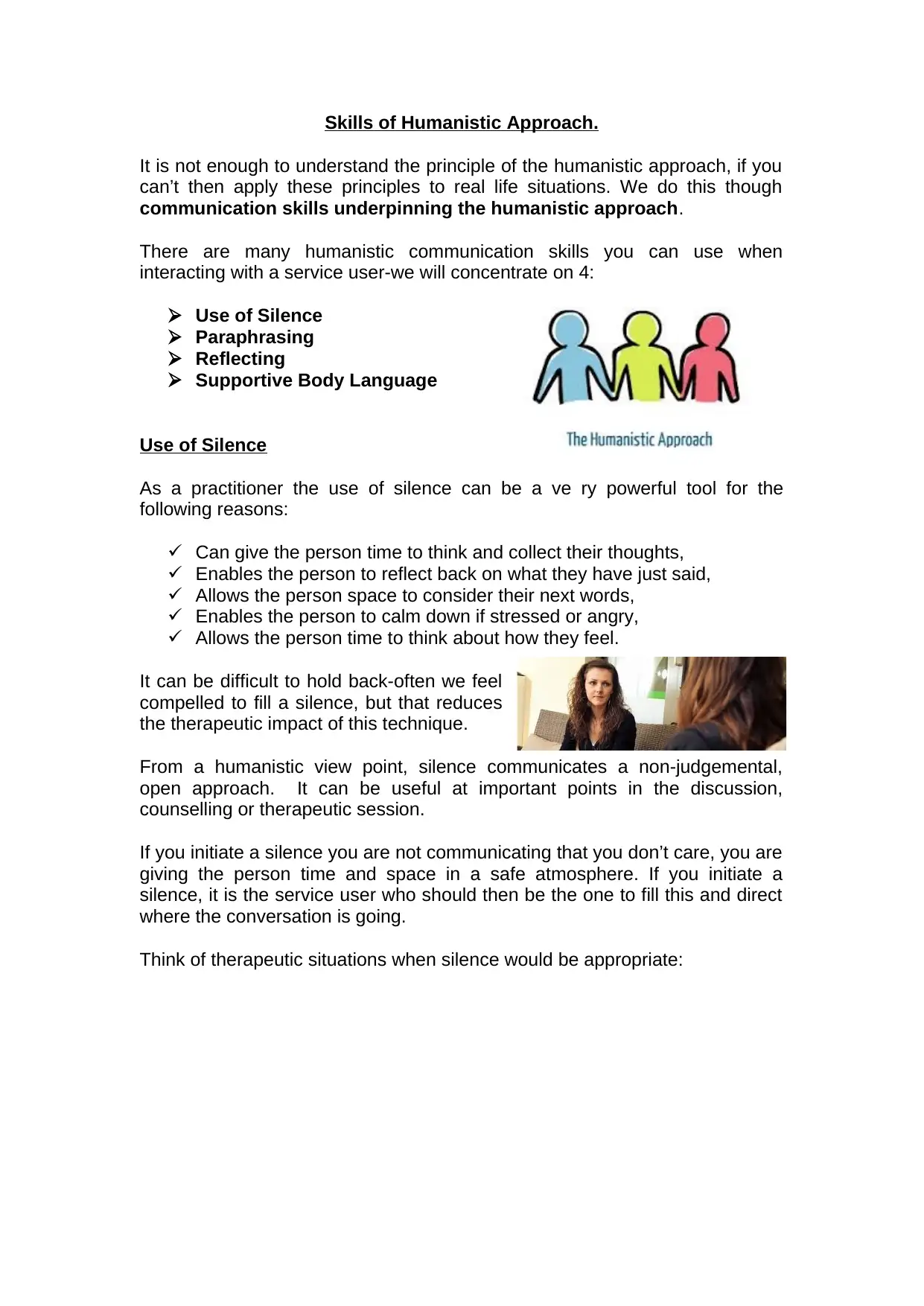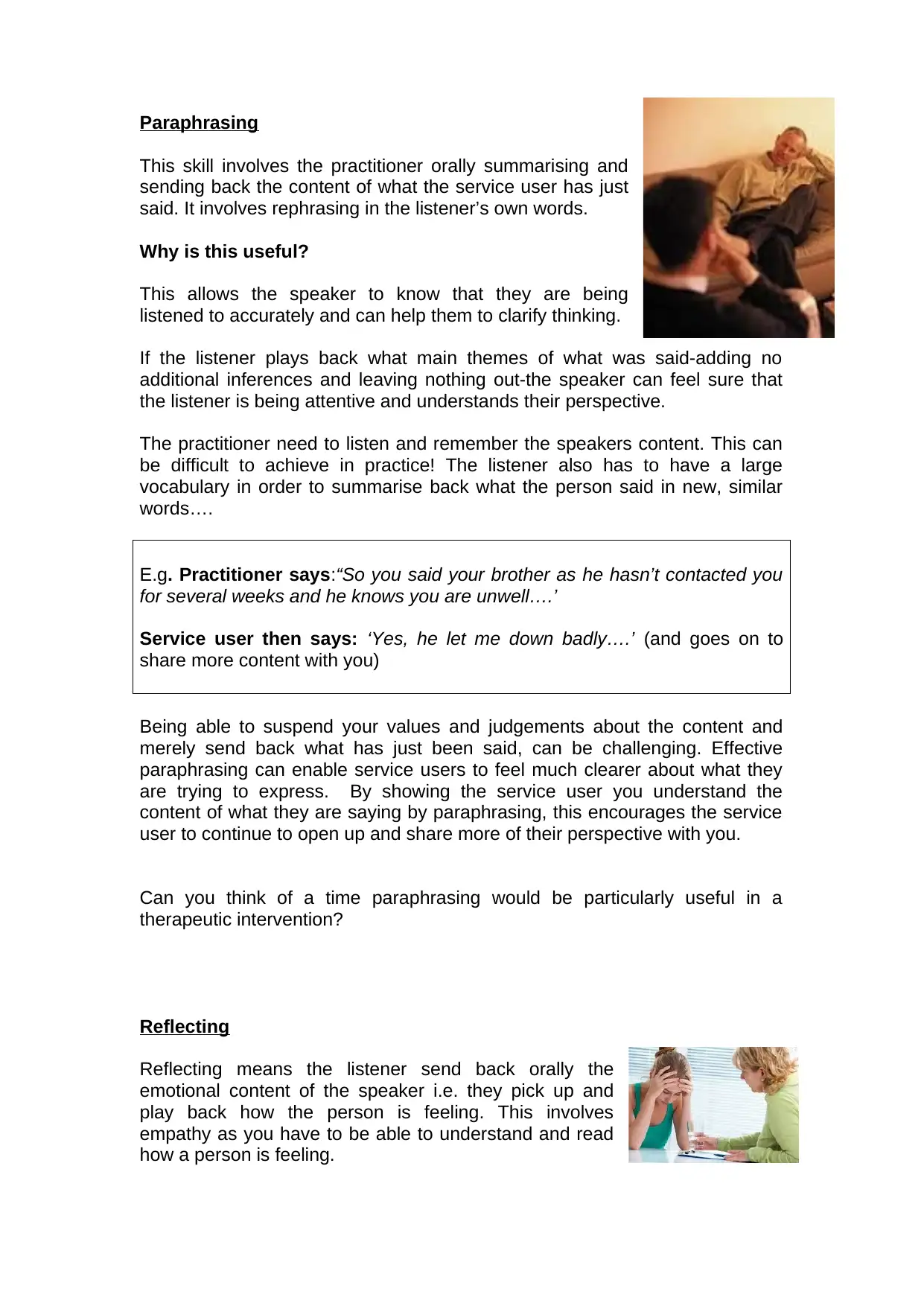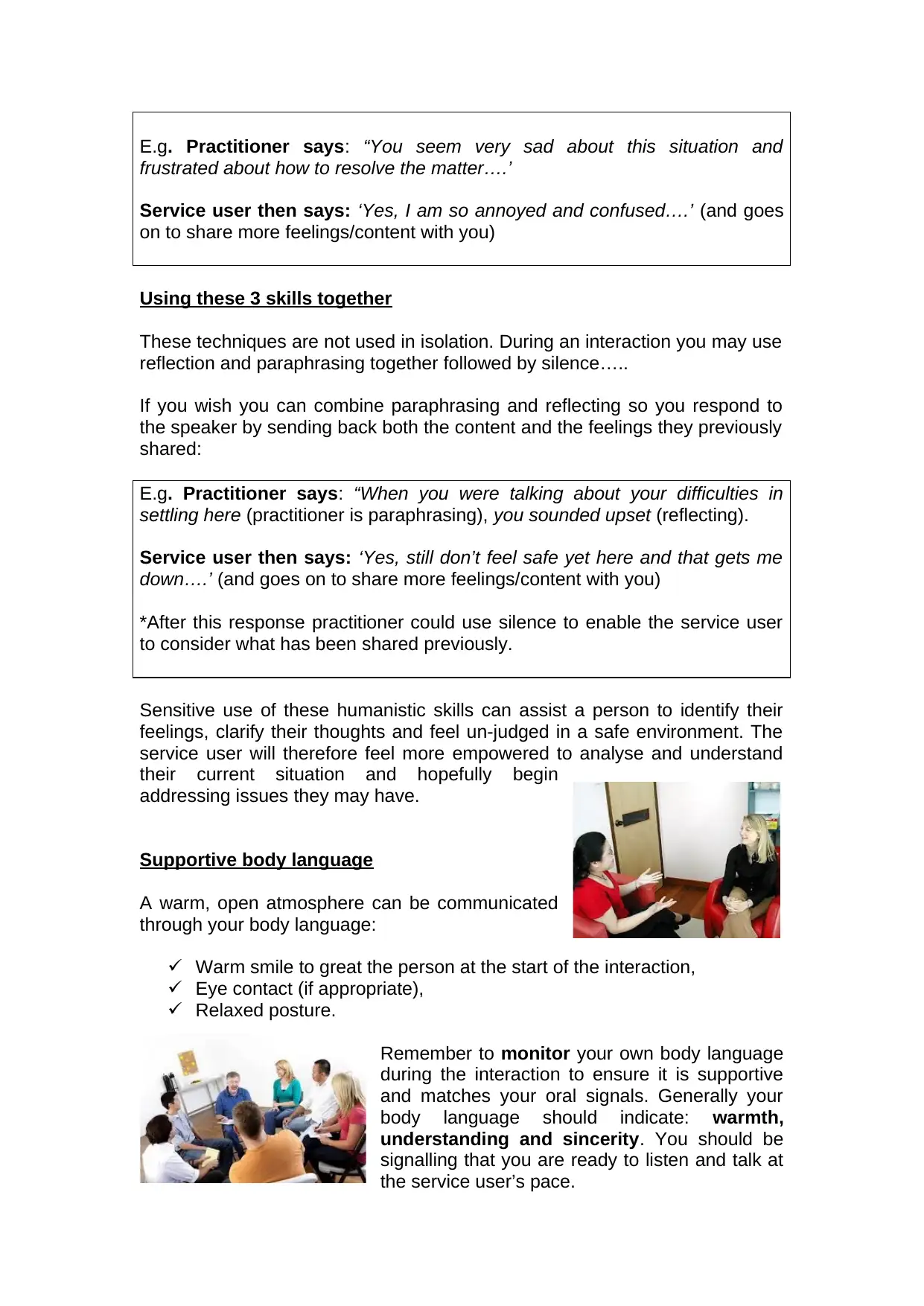Effective Application of Humanistic Approach Communication Skills
VerifiedAdded on 2019/09/16
|3
|931
|384
Homework Assignment
AI Summary
This assignment focuses on the practical application of the humanistic approach, emphasizing the crucial role of communication skills in real-life situations. It delves into four key humanistic communication skills: the use of silence, paraphrasing, reflecting, and supportive body language. The assignment explains how silence can be a powerful tool for allowing individuals to gather their thoughts and reflect, while paraphrasing ensures accurate understanding and clarification. Reflecting is described as a method to convey the emotional content of the speaker. The document also stresses the importance of combining these techniques and using supportive body language to create a warm, open atmosphere. By mastering these skills, practitioners can facilitate self-analysis, empower service users, and create a safe environment for addressing issues.

Skills of Humanistic Approach.
It is not enough to understand the principle of the humanistic approach, if you
can’t then apply these principles to real life situations. We do this though
communication skills underpinning the humanistic approach.
There are many humanistic communication skills you can use when
interacting with a service user-we will concentrate on 4:
Use of Silence
Paraphrasing
Reflecting
Supportive Body Language
Use of Silence
As a practitioner the use of silence can be a ve ry powerful tool for the
following reasons:
Can give the person time to think and collect their thoughts,
Enables the person to reflect back on what they have just said,
Allows the person space to consider their next words,
Enables the person to calm down if stressed or angry,
Allows the person time to think about how they feel.
It can be difficult to hold back-often we feel
compelled to fill a silence, but that reduces
the therapeutic impact of this technique.
From a humanistic view point, silence communicates a non-judgemental,
open approach. It can be useful at important points in the discussion,
counselling or therapeutic session.
If you initiate a silence you are not communicating that you don’t care, you are
giving the person time and space in a safe atmosphere. If you initiate a
silence, it is the service user who should then be the one to fill this and direct
where the conversation is going.
Think of therapeutic situations when silence would be appropriate:
It is not enough to understand the principle of the humanistic approach, if you
can’t then apply these principles to real life situations. We do this though
communication skills underpinning the humanistic approach.
There are many humanistic communication skills you can use when
interacting with a service user-we will concentrate on 4:
Use of Silence
Paraphrasing
Reflecting
Supportive Body Language
Use of Silence
As a practitioner the use of silence can be a ve ry powerful tool for the
following reasons:
Can give the person time to think and collect their thoughts,
Enables the person to reflect back on what they have just said,
Allows the person space to consider their next words,
Enables the person to calm down if stressed or angry,
Allows the person time to think about how they feel.
It can be difficult to hold back-often we feel
compelled to fill a silence, but that reduces
the therapeutic impact of this technique.
From a humanistic view point, silence communicates a non-judgemental,
open approach. It can be useful at important points in the discussion,
counselling or therapeutic session.
If you initiate a silence you are not communicating that you don’t care, you are
giving the person time and space in a safe atmosphere. If you initiate a
silence, it is the service user who should then be the one to fill this and direct
where the conversation is going.
Think of therapeutic situations when silence would be appropriate:
Paraphrase This Document
Need a fresh take? Get an instant paraphrase of this document with our AI Paraphraser

Paraphrasing
This skill involves the practitioner orally summarising and
sending back the content of what the service user has just
said. It involves rephrasing in the listener’s own words.
Why is this useful?
This allows the speaker to know that they are being
listened to accurately and can help them to clarify thinking.
If the listener plays back what main themes of what was said-adding no
additional inferences and leaving nothing out-the speaker can feel sure that
the listener is being attentive and understands their perspective.
The practitioner need to listen and remember the speakers content. This can
be difficult to achieve in practice! The listener also has to have a large
vocabulary in order to summarise back what the person said in new, similar
words….
E.g. Practitioner says:“So you said your brother as he hasn’t contacted you
for several weeks and he knows you are unwell….’
Service user then says: ‘Yes, he let me down badly….’ (and goes on to
share more content with you)
Being able to suspend your values and judgements about the content and
merely send back what has just been said, can be challenging. Effective
paraphrasing can enable service users to feel much clearer about what they
are trying to express. By showing the service user you understand the
content of what they are saying by paraphrasing, this encourages the service
user to continue to open up and share more of their perspective with you.
Can you think of a time paraphrasing would be particularly useful in a
therapeutic intervention?
Reflecting
Reflecting means the listener send back orally the
emotional content of the speaker i.e. they pick up and
play back how the person is feeling. This involves
empathy as you have to be able to understand and read
how a person is feeling.
This skill involves the practitioner orally summarising and
sending back the content of what the service user has just
said. It involves rephrasing in the listener’s own words.
Why is this useful?
This allows the speaker to know that they are being
listened to accurately and can help them to clarify thinking.
If the listener plays back what main themes of what was said-adding no
additional inferences and leaving nothing out-the speaker can feel sure that
the listener is being attentive and understands their perspective.
The practitioner need to listen and remember the speakers content. This can
be difficult to achieve in practice! The listener also has to have a large
vocabulary in order to summarise back what the person said in new, similar
words….
E.g. Practitioner says:“So you said your brother as he hasn’t contacted you
for several weeks and he knows you are unwell….’
Service user then says: ‘Yes, he let me down badly….’ (and goes on to
share more content with you)
Being able to suspend your values and judgements about the content and
merely send back what has just been said, can be challenging. Effective
paraphrasing can enable service users to feel much clearer about what they
are trying to express. By showing the service user you understand the
content of what they are saying by paraphrasing, this encourages the service
user to continue to open up and share more of their perspective with you.
Can you think of a time paraphrasing would be particularly useful in a
therapeutic intervention?
Reflecting
Reflecting means the listener send back orally the
emotional content of the speaker i.e. they pick up and
play back how the person is feeling. This involves
empathy as you have to be able to understand and read
how a person is feeling.

E.g. Practitioner says: “You seem very sad about this situation and
frustrated about how to resolve the matter….’
Service user then says: ‘Yes, I am so annoyed and confused….’ (and goes
on to share more feelings/content with you)
Using these 3 skills together
These techniques are not used in isolation. During an interaction you may use
reflection and paraphrasing together followed by silence…..
If you wish you can combine paraphrasing and reflecting so you respond to
the speaker by sending back both the content and the feelings they previously
shared:
E.g. Practitioner says: “When you were talking about your difficulties in
settling here (practitioner is paraphrasing), you sounded upset (reflecting).
Service user then says: ‘Yes, still don’t feel safe yet here and that gets me
down….’ (and goes on to share more feelings/content with you)
*After this response practitioner could use silence to enable the service user
to consider what has been shared previously.
Sensitive use of these humanistic skills can assist a person to identify their
feelings, clarify their thoughts and feel un-judged in a safe environment. The
service user will therefore feel more empowered to analyse and understand
their current situation and hopefully begin
addressing issues they may have.
Supportive body language
A warm, open atmosphere can be communicated
through your body language:
Warm smile to great the person at the start of the interaction,
Eye contact (if appropriate),
Relaxed posture.
Remember to monitor your own body language
during the interaction to ensure it is supportive
and matches your oral signals. Generally your
body language should indicate: warmth,
understanding and sincerity. You should be
signalling that you are ready to listen and talk at
the service user’s pace.
frustrated about how to resolve the matter….’
Service user then says: ‘Yes, I am so annoyed and confused….’ (and goes
on to share more feelings/content with you)
Using these 3 skills together
These techniques are not used in isolation. During an interaction you may use
reflection and paraphrasing together followed by silence…..
If you wish you can combine paraphrasing and reflecting so you respond to
the speaker by sending back both the content and the feelings they previously
shared:
E.g. Practitioner says: “When you were talking about your difficulties in
settling here (practitioner is paraphrasing), you sounded upset (reflecting).
Service user then says: ‘Yes, still don’t feel safe yet here and that gets me
down….’ (and goes on to share more feelings/content with you)
*After this response practitioner could use silence to enable the service user
to consider what has been shared previously.
Sensitive use of these humanistic skills can assist a person to identify their
feelings, clarify their thoughts and feel un-judged in a safe environment. The
service user will therefore feel more empowered to analyse and understand
their current situation and hopefully begin
addressing issues they may have.
Supportive body language
A warm, open atmosphere can be communicated
through your body language:
Warm smile to great the person at the start of the interaction,
Eye contact (if appropriate),
Relaxed posture.
Remember to monitor your own body language
during the interaction to ensure it is supportive
and matches your oral signals. Generally your
body language should indicate: warmth,
understanding and sincerity. You should be
signalling that you are ready to listen and talk at
the service user’s pace.
⊘ This is a preview!⊘
Do you want full access?
Subscribe today to unlock all pages.

Trusted by 1+ million students worldwide
1 out of 3
Related Documents
Your All-in-One AI-Powered Toolkit for Academic Success.
+13062052269
info@desklib.com
Available 24*7 on WhatsApp / Email
![[object Object]](/_next/static/media/star-bottom.7253800d.svg)
Unlock your academic potential
Copyright © 2020–2025 A2Z Services. All Rights Reserved. Developed and managed by ZUCOL.





